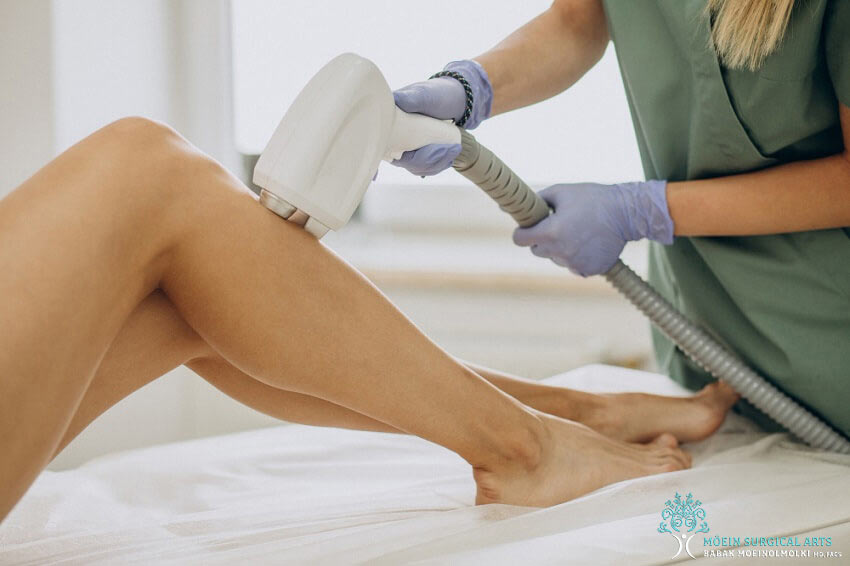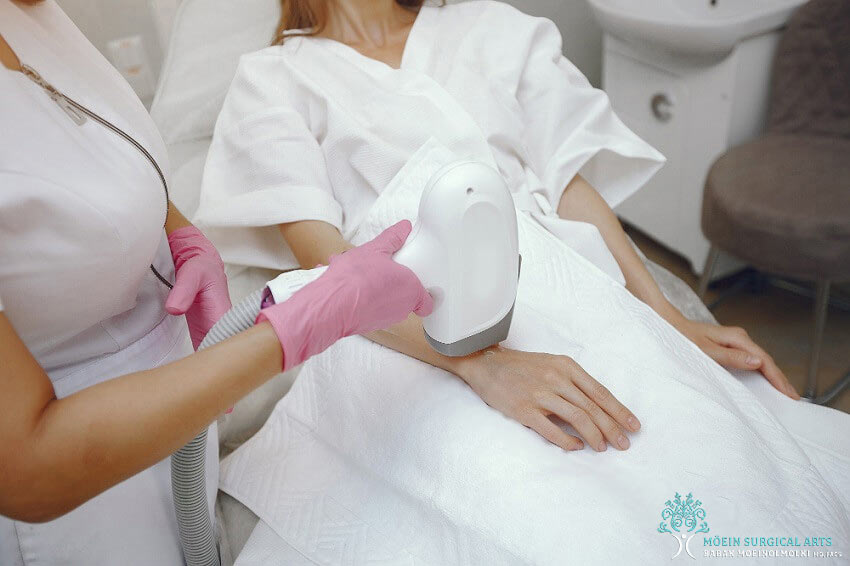
Isn’t the act of shaving annoying? When you want smooth, hair-free skin, using a razor is the most convenient way to remove unwanted hair. But shaving has so many side effects, some of them painful. Anytime you are raking a sharp blade against your skin, problems are bound to happen.
You are probably familiar with some of the unwanted effects of shaving.
Itching: Using a razor, particularly a dull one, can lead to folliculitis, otherwise known as razor burn. The itchiness caused by this issue can be exacerbated by using products that contain harsh chemicals such as alcohol, and artificial scents following your shaving session.
Inflammation: Speaking of folliculitis, razor burn can cause the formation of blisters and pimples, ingrown hairs, and inflamed hair follicles. None of these are very comfortable and some are downright unsightly.
Nicks and Cuts: Who hasn’t experienced an errant razor swipe that causes a slice in the skin? How frustrating!
Because shaving can lead to so many pesky problems, wouldn’t it be great if you could do away with shaving for good? Well, now you can. After all, why shave when you can turn to laser hair removal to rid your body of unwanted hair?
This cosmetic technique has been commercially available since 1995. Since then, both men and women have been able to develop the smoothest, most hair-free skin possible without razors, razor blades, and all the issues that come with the annoying habit of shaving.
Want to learn more about laser hair removal? You’ve come to the right place. We’re going to cover what the technique involves, how to prepare, what to expect from the results, and more information than you could shake a razor at. By the time we’re done, it’s a good bet you’ll toss out all your razors and schedule an appointment at a laser hair removal center near you.

Laser hair removal is considered a medical procedure. When you want hair removed from various areas of your body, the technician performing the procedure focuses a concentrated beam of light on the skin. This laser beam then removes the unwanted hair. Doesn’t that already sound better than raking a sharp blade across the skin?
When the laser is focused on the hair follicles, the light emitted from the laser is absorbed by the pigment in the hair. This causes the hair follicle to heat up and become damaged, preventing future hair growth.
Wouldn’t it be great if lasering the hair follicles would stop growing forever? Unfortunately, that doesn’t happen, but you can look forward to hair-free skin for some time. Lasering the hair away does cause growth delays for extended periods of time. How long the hair stays gone is different for each person. Laser hair removal tends to be more effective for individuals with light skin and dark hair. The technique can be used on all skin and hair types, however.
You are encouraged to have multiple laser hair removal sessions, and maintenance treatments if you want the hair to be removed and stay gone for the long term.
The most common areas of the body chosen for laser hair removal include the armpits, upper lip, chin, legs, and the bikini line. That being said, the laser technique can be used on nearly any body part except for ultra-thin areas like the eyelids. If you have tattoos, laser hair removal is not recommended, as the treatment can cause the coloring to fade.
There is a risk of damage to the skin when there isn’t enough contrast between the hair and the skin. As we mentioned, hair color and skin type can influence the results of laser hair removal. The idea is to have the pigment of the hair absorb the light, not the pigment of the skin. You want the high-intensity light beam to damage the hair follicle only while avoiding damage to the skin.
When there is little contrast to the hair and skin, such as when you have dark hair and dark skin, for example, skin damage can result. However, advances in laser technology have made laser hair removal an option for those with darker-colored skin. It all depends on the laser hair removal center and the technology used.
Other risks could include skin irritation and pigment changes to the skin. The irritation usually develops as redness and swelling around the treatment area, though these signs typically disappear within several hours of the hair removal treatment.
As far as pigment changes, laser hair removal techniques can darken or lighten the skin somewhat. These side effects can be temporary or permanent, depending on the person. Though, skin lightening usually affects those who fail to avoid sun exposure before or after the treatment and those with darker colored skin.
In rare cases, laser hair removal can lead to blistering, scarring, changes in skin texture, and crusting. The hair can become gray, and some people can develop excess hair growth around the treatment area, particularly on those with darker skin.
You should never use laser hair removal on the eyelids, eyebrows, or around the forehead because of the possibility of severe eye injury.

Laser hair removal tends to be less effective on hair colors that fail to absorb light well. These include the hair colors of red, blond, gray, and white. However, laser hair removal treatments are being developed for those with light-colored hair.
Because laser hair removal is a medical treatment, it is recommended that you only choose a cosmetic surgery or dermatology center for your appointment. Spas, salons, and other facilities that do not have medical personnel on hand may not be qualified to perform the hair removal technique and are even less prepared if something goes wrong. The technique should be performed by a doctor with experience with laser hair removal on your particular skin type.
Once you find a qualified professional to perform the service, schedule a consultation to determine if you are a suitable candidate for the laser treatment. During the consultation, the laser hair removal technician will review your medical history, discuss the risks, and take photos to be used for before and after assessments.
Medical history is important because the professional performing the service needs to know which medications you may be taking and whether you have a history of skin disorders.
When discussing the risks of the procedure, the professional will also discuss the benefits and manage your expectations, so that you know what to expect from the results of laser hair removal.
Taking photos doesn’t always occur, but the practice does benefit you because you will be able to see what your skin looked like before and after the procedure. The center also gets a before and after montage that can be used for marketing purposes.
If after the consultation you and the professional decide that laser hair removal is right for you, you will be scheduled for your appointment. As the time approaches, stay out of the sun at all costs. If you will be outside in the sunlight, be sure to wear a broad-spectrum, SPF-30 sunscreen to protect the treatment area.
If you tend to use a cream on your skin, avoid sunless skin creams that darken your skin, such as indoor tanning lotions. Your doctor can prescribe a skin bleaching cream to use prior to your procedure if you have a recent tan or darker-colored skin.
Since the purpose of laser hair removal is to rid your body of unwanted hair, you’ll want to keep that hair in place until your appointment. Avoid plucking or waxing the hair or using techniques like electrolysis for at least four weeks prior to your laser hair removal appointment.
And while you do want to toss out your razor, you are recommended to trim and shave the day before laser treatment. This helps to remove hair above the skin which can result in surface skin damage from burned hairs. Don’t worry. Shaving leaves the hair shaft intact below the surface, which is the part of the follicle that is targeted by laser hair removal.
You will also be told of medications to avoid before showing up for your procedure, which may include blood-thinning medications, aspirin, and anti-inflammatory drugs.
The best outcomes for laser hair removal come after two to six treatments. In many cases, you will pause for four to eight weeks between appointments for areas where hair grows quickly, such as on the upper lip. For areas where the hair grows slowly, such as the back, you may not return for 12 to 16 weeks.
During the procedure, you will don a pair of special goggles that protect your eyes from the high-intensity laser beam. An assistant may shave the treatment area once more and a topical anesthetic will be applied to reduce any discomfort while the beam is doing its work.
Once you are ready for the hair removal process, the doctor uses a hand-held laser instrument to apply the beam to the hair follicles. Some instruments have a cooling device on the tip to lessen the chance of side effects. Other centers use a cooling gel to do the same.
Once the laser is activated, the beam passes through your hair-free skin to the hair follicles. The intense heat caused by the laser damages the hair follicles, which prevents them from regrowing. You might feel a warm pinprick sensation and the cold from the cooling device or gel while the treatment is ongoing.
The technique only takes a few minutes for many areas, such as the upper lip. For larger areas, the technique may take up to an hour or longer.

Following the procedure, you may have redness or swelling around the treatment area for a few hours. An ice pack applied to the area can reduce discomfort. Make sure you continue to avoid sunlight and wear sunscreen as directed by your doctor to obtain the most favorable results.
As far as the results themselves are concerned, you should not expect the hairs to fall out immediately. Rather, you will shed the hair over a period of several days to several weeks. This is on account of the natural procession of the hair growth cycle. Because hair does grow in a cycle, the treatment works best when hair follicles are in the stage of newly developed growth.
Results vary depending on the individual. For many, laser hair removal results in months of smooth, hair-free skin. For others, the hair stays gone for years at a time. The treatment is never permanent, however. The hair will eventually grow back. When it does return, the hair follicles usually do so with a lighter and finer color.
If you are tired of shaving and want hair-free skin on various areas of your body, choose hair removal by an expert familiar with laser-assisted techniques. Dr. Babak Moein of Moein Surgical Arts is the professional to see. You can schedule a consultation with Dr. Moein to learn about the risks, benefits, and results of this amazing hair removal technique by dialing .